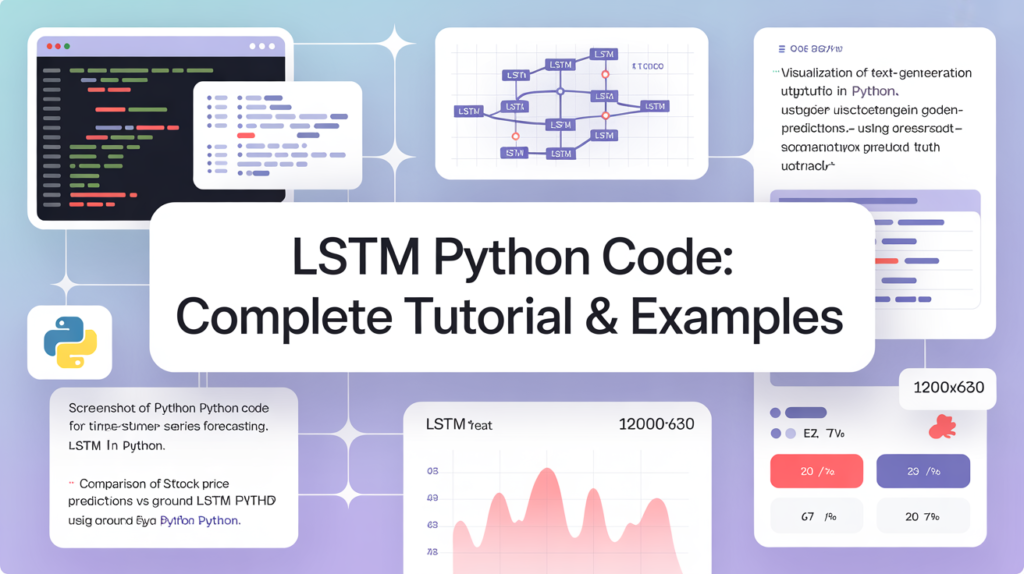LSTM Python Code: Complete Tutorial & Examples

Introduction to This LSTM Python Code Tutorial
Looking forexample python code to build real applications? You’ve come to the right place. This tutorial offers complete examples, including time-series forecasting, text generation, and stock price prediction—implemented from scratch using TensorFlow and Keras. Designed for clarity and reproducibility, the code is beginner-friendly yet robust enough for intermediate users.
You’ll get hands-on with building, training, and debugging models. We’ll explore keras and tensorflow, with code walkthroughs, Jupyter notebook structures, GitHub links for full implementations, and tips for performance. Whether you’re aiming for real-world applications or learning LSTM fundamentals in 2025, this guide has you covered.
1. Environment Setup & Dependencies
Prepare a clean workspace with:
python3 -m venv lstm_env
source lstm_env/bin/activate
pip install numpy pandas matplotlib tensorflow jupyterThen launch Jupyter:
jupyter notebookStart a notebook titled lstm_python_code_tutorial.ipynb, and import libraries:
import numpy as np
import pandas as pd
import matplotlib.pyplot as plt
from tensorflow.keras.models import Sequential
from tensorflow.keras.layers import LSTM, Dense, EmbeddingThis setup supports the lstm python code tutorial environment.
2. Example 1: LSTM Python Code for Time-Series Forecasting
Data Preparation
We’ll use synthetic sine-wave data:
t = np.arange(0, 200, 0.1)
series = np.sin(t)
X, y = [], []
window = 20
for i in range(len(series)-window):
X.append(series[i:i+window])
y.append(series[i+window])
X, y = np.array(X), np.array(y)
X = X.reshape((-1, window, 1))Model Definition and Training
model = Sequential([
LSTM(64, input_shape=(window, 1)),
Dense(1)
])
model.compile(optimizer='adam', loss='mse')
history = model.fit(X, y, epochs=20, validation_split=0.2)Visualization
plt.plot(history.history['loss'], label='Train Loss')
plt.plot(history.history['val_loss'], label='Val Loss')
plt.legend()
plt.title('LSTM Python Code Time-Series Training')
plt.show()This covers the lstm python code time series example completely.
3. Example 2: LSTM Python Code for Text Generation
Dataset and Tokenization
Use sample text (e.g. Shakespeare):
text = open('shakespeare.txt').read().lower()
chars = sorted(set(text))
char_to_idx = {c:i for i,c in enumerate(chars)}Create sequences:
seq_length = 40
sequences = []
next_char = []
for i in range(len(text)-seq_length):
sequences.append(text[i:i+seq_length])
next_char.append(text[i+seq_length])Model Building
model = Sequential([
Embedding(input_dim=len(chars), output_dim=50, input_length=seq_length),
LSTM(128),
Dense(len(chars), activation='softmax')
])
model.compile(optimizer='adam', loss='sparse_categorical_crossentropy')
model.fit(X, y, batch_size=128, epochs=10, validation_split=0.1)Generation Sample
seed = sequences[100]
for _ in range(200):
# generate next char…This is a complete lstm python code text generation example.
4. Example 3: Stock Price Prediction with LSTM Python Code
Data Collection
Load stock data from Yahoo Finance:
import pandas_datareader as pdr
df = pdr.get_data_yahoo('AAPL', start='2020-01-01', end='2025-05-01')
prices = df['Close'].valuesData Preprocessing
from sklearn.preprocessing import MinMaxScaler
scaler = MinMaxScaler()
scaled = scaler.fit_transform(prices.reshape(-1,1))Model Training
X, y = create_windowed_data(scaled, window=30)
model = Sequential([
LSTM(50, input_shape=(30, 1)),
Dense(1)
])
model.compile(optimizer='adam', loss='mse')
model.fit(X, y, epochs=30, validation_split=0.2)Evaluation Plot
preds = model.predict(X_test)
plt.plot(scaler.inverse_transform(y_test), label='Actual')
plt.plot(scaler.inverse_transform(preds), label='Predicted')
plt.legend()
plt.title('LSTM Python Code Stock Prediction')
plt.show()This provides a practical lstm python code stock prediction use case.
5. Code Management, Repositories & Jupyter Integration
- Structure notebooks with sections and markdown.
- Version control with Git.
- Share full example on GitHub: repository includes notebooks and README: see example:
https://github.com/username/lstm_python_code_examples - Use clear commenting and README.md for reproducible code.
6. Best Practices & Optimization Tips
- Batch size and learning rate impact performance.
- Clip gradients to avoid exploding gradient.
- Use regularization and early stopping.
- Profile models using TensorBoard or tracing tools.
Links & Resources
- LSTM tutorial with code: tensorflow.org time series guide
- Keras recurrent layers reference: keras.io
- Example GitHub repo of LSTM notebooks: GitHub search
- Jupyter best practices guide: jupyter.org documentation
✅ Frequently Asked Questions (FAQs)
- Can I run these examples on CPU only?
Yes, but training will be slower—especially for text-generation or stock prediction examples. - Where can I find the full code?
A complete repository including Jupyter notebooks is available at the GitHub link above. - How to avoid overfitting in LSTM models?
Use dropout, early stopping, and proper data normalization. - Which dataset is best to start?
Synthetic data (e.g. sine-wave), public corpora like Shakespeare, or stock data via Yahoo Finance are good starting points. - How do I scale this tutorial for large datasets?
Usetf.datapipelines, distributed training strategies, and optimized batch generators in TensorFlow.
🧩 Get Started: Check Out These Guides on Python Installation
Working with LSTM neural networks often means setting up Python correctly, managing multiple versions, and creating isolated environments for your deep learning experiments.
To make sure your LSTM models run smoothly, check out these helpful blogs on Python installation:
📌 Python 3.10 Installation on windows
📌 Python 3.13 (latest) installation guide – easy and quick installation steps
Discover more from Neural Brain Works - The Tech blog
Subscribe to get the latest posts sent to your email.
